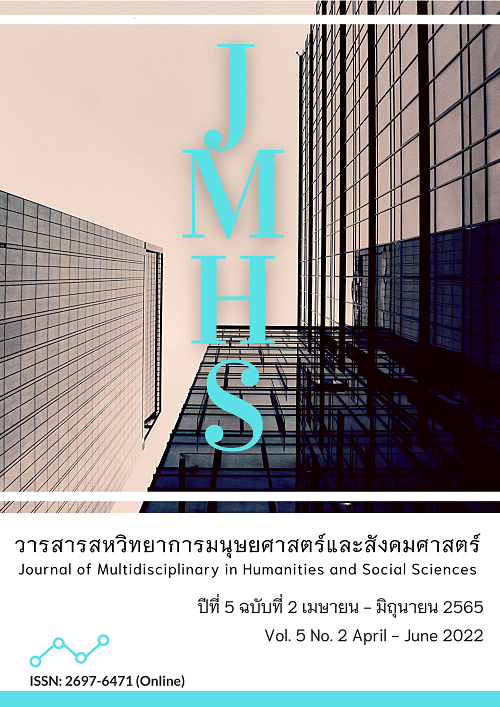A Study the Practice of Vipassana Meditation in The Viitathadhana Sutta
Main Article Content
Abstract
The objectives of this paper were 1) to study the content and important principles of the Viitathadhana Sutta and 2) to study the Dhamma principles in the Viitathadhana Sutta to support the practice of Vipassana Meditation. Data were collected from the Tripitaka, commentary, supreme, books, and research papers in order to present the research results by analyzing and synthesizing the data in a descriptive manner. The results of the research showed that the Viitathadhana Sutta is the Sutra that presents 7 wealth: 1) Trust, wealth is faith; 2) Siladhana wealth is morality; 3) Hirithana wealth is shame; 4) Ottapdhana wealth is the fear of sin; 5) Sutthana wealth is the disciple; 6) The wealth is the donation; and 7) Wisdom Thana wealth is the 7 wealth of wisdom Whoever is a woman or a man is rich in a world where nothing can be explored by gods and humans. Therefore, those who are wise, when remembering the teachings of the Buddhas, should practice morality, devotion, and sincerity to be a contributing factor to the practice of Vipassana. Praying at the end of the path to nirvana.
Article Details

This work is licensed under a Creative Commons Attribution-NonCommercial-NoDerivatives 4.0 International License.
Views and opinions appearing in the Journal it is the responsibility of the author of the article, and does not constitute the view and responsibility of the editorial team.
References
คณาจารย์แห่งโรงพิมพ์เลี่ยงเชียง. (2535). วิชา ธรรมวิภาค น.ธ.โท ฉบับมาตรฐาน. กรุงเทพฯ: โรงพิมพ์เลี่ยงเชียง.
พระพุทธโฆสเถระ. (2554). คัมภีร์วิสุทธิมรรค. (สมเด็จพระพุฒาจารย์ (อาจ อาสภมหาเถร), ผู้แปล). (พิมพ์ครั้งที่ 10). กรุงเทพฯ: ธนาเพรส.
พระภัทรชัยญกรณ์ อูดสวย. (2564). การบริหารการศึกษาตามหลักพุทธธรรมของโรงเรียนตำรวจตระเวนชายแดน. วารสารนวัตกรรมการจัดการศึกษาและการวิจัย, 4(3), 83-92.
พระมหาโพธิวงศาจารย์ (ทองดี สุรเตโช). 2559. พจนานุกรมไทยบาลี. กรุงเทพฯ: วัดราชโอรสาธิราม.
พระสมชาย บัวแก้ว, พระมหาบุญศรี วงค์แก้ว และ สุเชาวน์ พลอยชุม. (2564). อภิสมาจาร: กระบวนการพัฒนาบุคลิกภาพตามแนวพระพุทธศาสนา. วารสารศิลปการจัดการ, 5(3), 895-907.
พระโสภณมหาเถระ (มหาสีสยาดอ). (2553). วิปัสสนาชุนี. (จำรูญ ธรรมดา, ผู้แปล). กรุงเทพฯ: ประยูรสาส์นการพิมพ์.
มหาจุฬาลงกรณราชวิทยาลัย. (2539). พระไตรปิฎกภาษาไทย ฉบับมหาจุฬาลงกรณราชวิทยาลัย. กรุงเทพฯ: โรงพิมพ์มหาจุฬาลงกรณราชวิทยาลัย.
ศุภวรรณ การุญญะวีร์. (2564). การบริหารจัดการแหล่งเรียนรู้ภายในสถานศึกษาตามหลักสัปปายะ 7 วิถีใหม่. วารสารนวัตกรรมการจัดการศึกษาและการวิจัย, 4(3), 75-82.
สมเด็จพุทธโฆษาจารย์ (ป.อ.ปยุตโต). (2560). พจนานุกรมพุทธศาสน์ ฉบับประมวลศัพท์. (พิมพ์ครั้งที่ 31). กรุงเทพฯ: สหธรรมิก.
Damnoen, P. S., Chaiworamankul, Y., Thammawatsiri, P. A., & Soontrondhammanitus, P. (2021). Buddhist Ethics and the way of Living in Daily Life: An Analysis of Genital Malfeasances (Kamesumicchacara). Turkish Journal of Computer and Mathematics Education, 12(8), 2943-2948.
Tan, C. C., & Damnoen, P. S. (2020). Buddhist Noble Eightfold Path Approach in the Study of Consumer and Organizational Behaviors. Journal of MCU Peace Studies, 8(1), 1–20.


